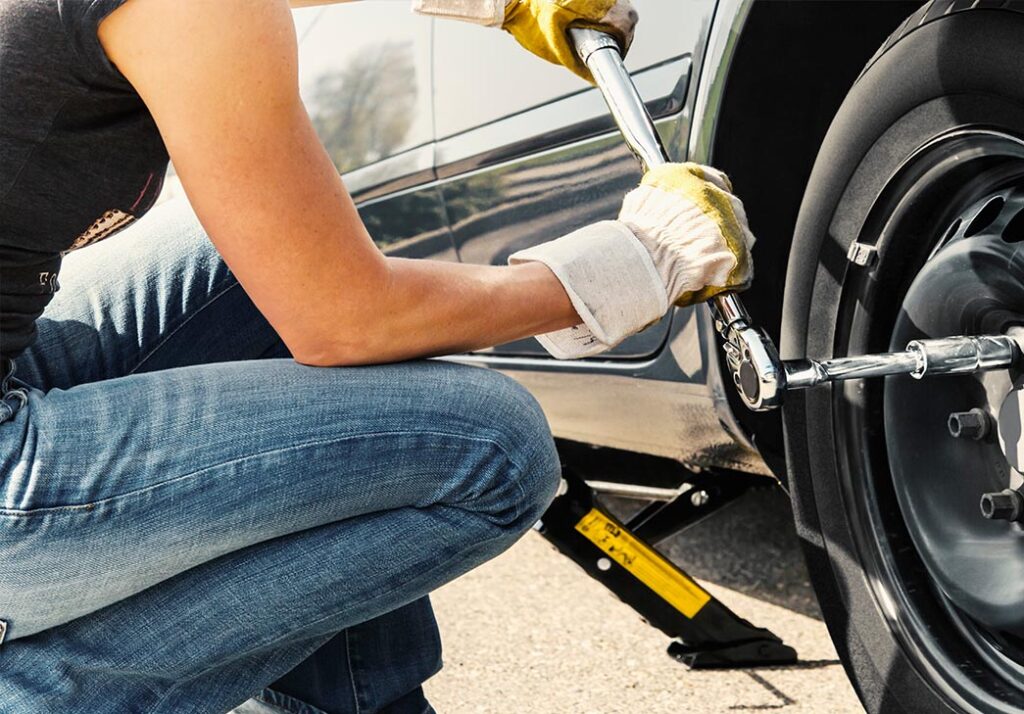Getting a flat tire is no cause for panic.
Several years ago, I set out for a multi-day backcountry hiking trip with my sister. The access point for our hike was a remote parking lot, an hour’s drive down a narrow gravel logging road. We didn’t pass a single vehicle on our way in and though there were a few parked cars when we finally reached our destination, we didn’t encounter anyone else.
Slipping on our backpacks, we hiked into the wilderness to spend the next few days disconnecting from our busy lives. Arriving back at the parking lot after our exhilarating trek and dreaming of a hot shower, we were dismayed to find our car had a flat tire. Looking around, we could see even fewer cars parked in the lot and not a soul in sight. I also had the sinking realization that our remote location meant no cell phone service, so I wasn’t going to be able to whip out my phone to call for roadside assistance. We were entirely on our own.
Never having changed a tire, I was trying not to panic. Fortunately, my ever-resourceful sister had been changing the tires on her car for years and took charge. Hauling out the spare, we tackled the problem and soon we were driving back to civilization feeling exhilarated that we’d risen to the challenge.
Here’s a quick guide to solving the problem and getting you on your way.
1. First Things First
If you hear that familiar thumping noise when driving, slow down and carefully pull over to park in a safe area as soon as possible. Make sure that you leave yourself enough room to safely move around your car without the danger of having another vehicle hit you. Put on the parking brake and turn on your emergency flashers. If you have a reflective warning sign, place it several feet behind your car to warn other drivers. Don’t try and keep driving with a flat tire. You could damage your car and lose control.

2. Get Everything Ready
Place wedges behind the tires opposite to the one you’ll be changing. If you need to change a rear tire, place a wedge behind each front tire or the other way around to prevent your vehicle from rolling. If you don’t have wedges, use large stones instead.
Remove the spare tire from your trunk along with your jack. Most cars have these stored in a spot underneath the floor of your trunk.
3. Remove the Hubcap and Loosen the Nuts
If your car has a hubcap covering the lug nuts, you’ll need to remove it using the flat end of the built-in lug wrench that’s part of the jack. Next, loosen the lug nuts on the wheel with the damaged tire by applying pressure in a counter clockwise fashion. You’ll only need to loosen the nuts about half a turn. Don’t remove them completely. If you have trouble loosening a nut, use your foot or knee to add leverage on the wrench handle.
4. Raise your car
Next, place your jack on the strongest part of your vehicle’s frame. Refer to your owner’s manual which will give you specific information about where to place your jack. Raise the jack until the damaged tire is about 6 inches off the ground. Never put any part of your body under the vehicle when it’s being jacked up.
5. Remove the damaged tire and put on the spare
Once the vehicle is lifted, remove the loosened lug nuts. Now you can remove the damaged tire from the hub by gripping its treads and pulling it towards you. Place the tire flat on the ground so it doesn’t roll away.
Place your spare tire onto the wheel by lining up the holes with the bolts. Place the lug nuts back on and tighten by hand turning them in a clockwise direction.
6. Lower the car and tighten the Lug Nuts
Lower your vehicle until the spare tire is resting on the ground but the full weight of the vehicle is still not fully on the tire. Using the lug wrench, tighten the nuts as much as you can, pushing down on the wrench with your full body weight.
Lower the vehicle the rest of the way down to the ground and remove the jack. If you removed a hubcap and it fits on the spare, replace it. Otherwise, stow it away with the rest of your equipment and the damaged tire.
7. Check the tire pressure
Before driving away, check the tire pressure on your spare to make sure it’s safe to drive on. If the pressure is low, make your way slowly to the nearest gas station to inflate it.
You shouldn’t drive long distances or highway speeds on a spare tire. Make your way to the nearest mechanic and have your damaged tire repaired if possible or have it replaced.




